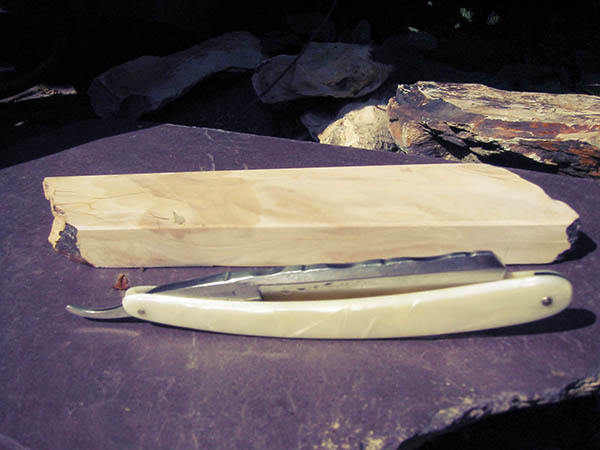Results 1 to 10 of 59
Thread: BUBBLING GOTICULE
Threaded View
-
09-27-2009, 09:35 PM #23Coticule researcher

- Join Date
- Jan 2008
- Location
- Belgium
- Posts
- 1,872
Thanked: 1212
I can verify that come substances are capable of penetrating a Coticule.
I had this hone, made from a piece of raw Coticule, that I had picked up at an old abandoned mine.
The slab of stone I managed to cut out of the rock, turned out with a small cavity. I filled the void with a paste I made from candle wax and Coticule powder. I heated the stone till the molten pasted started to flow into the void.
To my surprise also the surrounding area absorbed part of the wax. I lapped a good part of the hone, but the slight discoloration stayed visible. There was no disadvantage for honing. The stone performed as good as before (I only filled the void for cosmetic purposes) and I don't recall any foaming (wax isn't oil of course).
Here's a picture:

You can clearly see where the wax soaked into the hone.
As far as Neil Millers excellent post goes:
As far as I know, Coticule layers are all sandwiched between Blue schist. Some of that schist contains enough spessartine garnets to have honing qualities of its own. (Belgian Blue whetstone).
Here's a list of the mineralogical components of Coticules:
Spessartine (the actual garnets)
Muscovite
Paragonite
Quartz
Chlorite Mg (a greenish mineral)
Hematite (little in Coticule, a lot in BBW)
Apatite
Rutile (titanium dioxide, a very common pigment in white paint)
Koalinite (also common in paint and as filler in paper production)
Andalousite
I lack the knowledge to really tell if some of those would form a suspension with water that easily foams. Titanium dioxide and Kaolinite seem the most likely candidates in that field. Kaolinite (2 Mohs) is one of the softest elements found in Coticules. We are talking about a very soft stone that forms slurry from merely rubbing a razor over it. So we should probably look at those elements in the first place.
Chlorite (2.5 Mohs) is very soft as well, but in high concentration it would add a typical green hue to the hone.
Beware that I am talking about "Coticule" rock as it is found in the Venn Stavelot massive in Belgium. Coticule formation in the geological sense is a very interesting phenomenon and well studied all around the world. Not all Coticule formations have the same mineralogical composition so we have to be careful with quoting literature about other finding spots of Coticule (with too impure or narrow veins for honing purposes).
Best regards,
Bart.Last edited by Bart; 09-27-2009 at 11:33 PM.
-
The Following User Says Thank You to Bart For This Useful Post:
niftyshaving (12-28-2009)


 2Likes
2Likes LinkBack URL
LinkBack URL About LinkBacks
About LinkBacks






 Reply With Quote
Reply With Quote